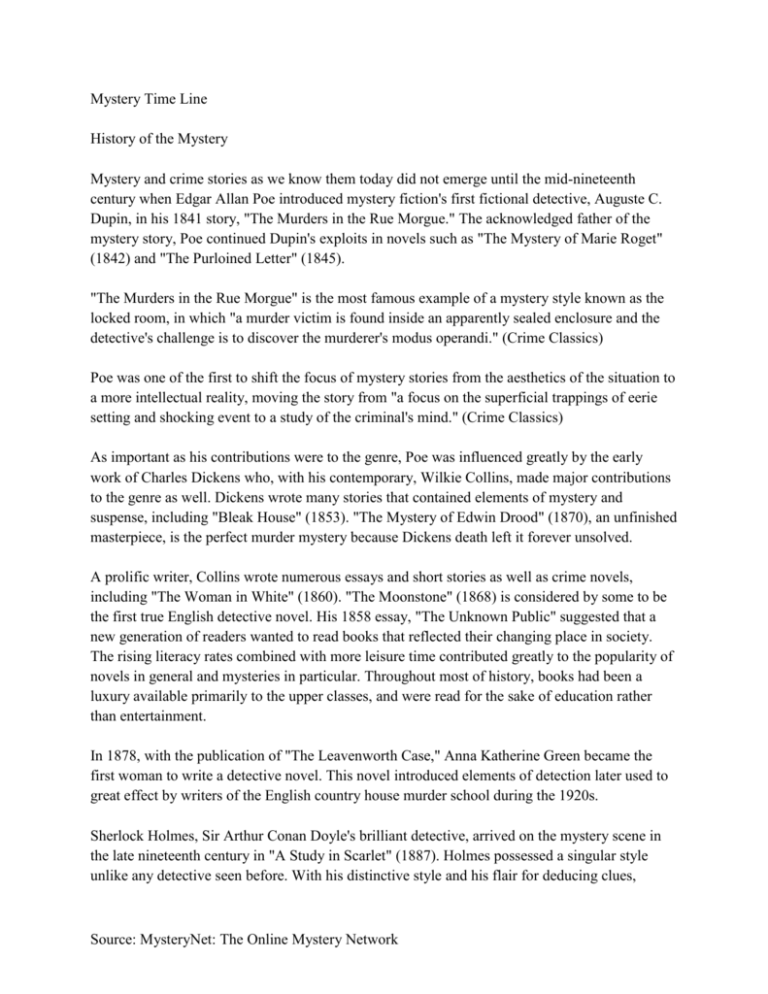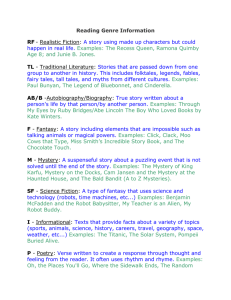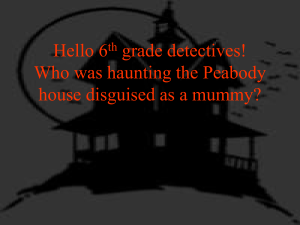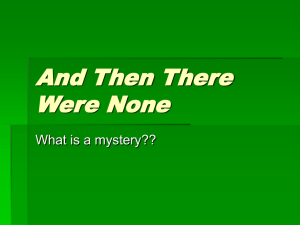Mystery Time Line History of the Mystery Mystery and crime stories
advertisement

Mystery Time Line History of the Mystery Mystery and crime stories as we know them today did not emerge until the mid-nineteenth century when Edgar Allan Poe introduced mystery fiction's first fictional detective, Auguste C. Dupin, in his 1841 story, "The Murders in the Rue Morgue." The acknowledged father of the mystery story, Poe continued Dupin's exploits in novels such as "The Mystery of Marie Roget" (1842) and "The Purloined Letter" (1845). "The Murders in the Rue Morgue" is the most famous example of a mystery style known as the locked room, in which "a murder victim is found inside an apparently sealed enclosure and the detective's challenge is to discover the murderer's modus operandi." (Crime Classics) Poe was one of the first to shift the focus of mystery stories from the aesthetics of the situation to a more intellectual reality, moving the story from "a focus on the superficial trappings of eerie setting and shocking event to a study of the criminal's mind." (Crime Classics) As important as his contributions were to the genre, Poe was influenced greatly by the early work of Charles Dickens who, with his contemporary, Wilkie Collins, made major contributions to the genre as well. Dickens wrote many stories that contained elements of mystery and suspense, including "Bleak House" (1853). "The Mystery of Edwin Drood" (1870), an unfinished masterpiece, is the perfect murder mystery because Dickens death left it forever unsolved. A prolific writer, Collins wrote numerous essays and short stories as well as crime novels, including "The Woman in White" (1860). "The Moonstone" (1868) is considered by some to be the first true English detective novel. His 1858 essay, "The Unknown Public" suggested that a new generation of readers wanted to read books that reflected their changing place in society. The rising literacy rates combined with more leisure time contributed greatly to the popularity of novels in general and mysteries in particular. Throughout most of history, books had been a luxury available primarily to the upper classes, and were read for the sake of education rather than entertainment. In 1878, with the publication of "The Leavenworth Case," Anna Katherine Green became the first woman to write a detective novel. This novel introduced elements of detection later used to great effect by writers of the English country house murder school during the 1920s. Sherlock Holmes, Sir Arthur Conan Doyle's brilliant detective, arrived on the mystery scene in the late nineteenth century in "A Study in Scarlet" (1887). Holmes possessed a singular style unlike any detective seen before. With his distinctive style and his flair for deducing clues, Source: MysteryNet: The Online Mystery Network 2 Holmes, with his ever-reliable sidekick, Dr. Watson, quickly became indispensable to mystery readers everywhere. The genius of Conan Doyle was reflected in his creation of a character whose intelligence was formidable, turning the solving of crimes into a science. Readers may have found his deductive powers too intimidating were it not for the presence of Dr. Watson, always nearby to bring Holmes back down to earth with the soothing voice of reason. By the 1920s British mysteries had become extremely popular, particularly the cozy, a style of mystery usually featuring "a small village setting, a hero with faintly aristocratic family connections, a plethora of red herrings and a tendency to commit homicide with sterling silver letter openers and poisons imported from Paraguay." (Murder Ink) The 1920s ushered in the Golden Age of mystery fiction. A time of growing prosperity in both England and America, the popularity of mystery fiction was at an all-time high. No longer used only to describe the period in history, Golden Age refers as well to the style of writing itself. Crime in these stories strictly adhere to a prescribed format with little or no variation. A writer emerged during this time whose name became synonymous with Golden Age fiction. Agatha Christie wrote more than 80 novels, spanning a career of 50-plus years, and is today probably the best-known mystery writer in history. Christie has "entertained more people for more hours at a time than almost any other writer of her generation." (Great Detectives) Christie's "The Mysterious Affair at Styles" (1920) introduced the Belgian sleuth Hercule Poirot, who along with Jane Marple, Christie's endearing mystery-solving spinster, remain two of mystery fiction's most popular characters. Christie perfected the cozy style over the next decade with titles like "The Murder at the Vicarage" and "The Murder of Roger Ackroyd," among many others. While Christie may have been the most recognizable Golden Age author, another writer at the time was also helping to define the genre. Dorothy L. Sayers, whose first mystery was published in 1923, introduced Lord Peter Wimsey, a detective whose style and intelligence won over many readers and made Sayers one of the most popular authors of her time. During the height of Golden Age fiction's popularity, London publisher Allen Lane came up with an idea that further helped to expand the availability of mysteries to the public. Along with his two brothers, he obtained limited rights to hardcover books written by Sayers and others. Their new paperback line was issued in 1935 with only 10 titles and quickly expanded to 70 titles within a year. Penguins, as they were called, were easily accessible to the public due to their 3 much lower cost and availability in department stores, where most of the public shopped at the time. These paperbacks helped to bring mysteries, along with other types of fiction as well, to the public. American detective fiction reached its zenith in the 1930s and 40s with the immense popularity of Ellery Queen, a pseudonym used by two American cousins, Manfred B. Lee and Frederic Dannay. Their first collaboration, "The Roman Hat Mystery," published in 1929, featured an amateur detective named Ellery, who solved mysteries with his father, Richard Queen. Ellery Queen proved to be so popular that, in all, the two authors wrote 33 novels spanning over 40 years featuring the father and son team. They later created another popular character, Drury Lane, introduced in 1932. With Ellery Queen, Lee and Dannay had "successfully adapted the Golden Age format to the American scene." (Crime Classics) At the same time that Golden Age fiction was on the rise, another type of mystery was taking shape. Black Mask or hard-boiled fiction was born in the 1920s with the rise of popular magazines known as pulps. The most famous of these, Black Mask, originally published adventure stories of all kinds, but eventually devoted its pages to detective fiction exclusively. The magazine came to symbolize the hard-boiled school of writing, with contributing writers like Dashiell Hammett and Raymond Chandler. Under editor Joseph Thompson Shaw's direction, Black Mask "established a revolutionary direction for the detective story." (Crime Classics) Shaw was attempting to create a new kind of detective novel. He wanted the stories to reflect the reality of life in America at the time. Such characters as Dashiell Hammett's Sam Spade and Raymond Chandler's Philip Marlowe were hard-edged men, tough guys who lived by strict codes of honor. Sam Spade was later immortalized on the big screen in the 1941 film noir classic "The Maltese Falcon." The '30's also gave birth to the "quirky" detective, sleuths of unusual or eccentric personalities. One of the most notable was Earl Derr Bigger's creation, Charlie Chan, who used the sage wisdom of the Orient to solve crimes all over the world; his popularity spawned a "Charlie Chan" industry in books, movies, radio, and television. Another author who got his start writing for Black Mask was Erle Stanley Gardner, creator of the crime-solving attorney Perry Mason. First introduced in 1933 in "The Case of the Velvet Claws," Mason tackled cases with his friend, detective Paul Drake, and his long-time secretary Della Street. In case after case, Mason went head-to-head in court with District Attorney Hamilton Burger, usually forcing a confession from the unsuspecting guilty party during their testimony on the stand. 4 Perry Mason has been featured in countless novels and films over the years and was the subject of a long-running television series that began in 1957 and ran for 10 seasons. In 1947, A new writer, Mickey Spillane, emerged on the mystery scene. When his book, "I, The Jury" appeared, marking the first appearance of ultra-tough guy Mike Hammer, it created a sensation. With his strong emphasis on sex and violence, Spillane appealed mostly to male readers, and "I, The Jury" became the best-selling mystery in history up until that time, selling over six million copies. Critics hated Spillane's books and their heavy focus on blood and guts, but the public couldn't seem to get enough. Spillane only wrote five more Mike Hammer novels, and all were extremely successful. The public's love of mysteries wasn't limited to the printed page. Not only were radio mysteries like "The Shadow" one of the most popular forms of entertainment in the 1940s, the arrival of television brought mystery in an entirely new direction. Mystery on television has proved to be an endless source of diversion and delight for fans the world over. Since the birth of the medium, TV has provided mystery lovers with a seemingly endless stream of colorful characters over the years and into the present. Characters such as Perry Mason and Simon Templar ("The Saint") were extremely popular during the early years of TV, followed more recently by the likes of Lieutenant Columbo ("Columbo"), Jim Rockford ("The Rockford Files"), and Jessica Fletcher ("Murder, She Wrote"), among many others. Another type of crime fiction, police procedural, surfaced in the 1940s, and its style coincided perfectly with the advent of television. As its name implies, it differed from other styles of crime writing because of its realistic portrayal of police methods. The stories were always presented from the point of view of the police, usually in a gritty, realistic style. The most successful writer of this type of fiction was Ed McBain (1926- ), who set his stories in the fictional 87th precinct in a big-city police force. The popular TV series "Dragnet" followed this format perfectly, and was followed later by shows such as "Hawaii 5-O," "Kojak," and "Hill Street Blues," all of which developed loyal followings throughout their runs on the small screen. Just as mystery throughout its history hasn't been limited to the page, it hasn't been limited to one audience. Some of the most popular mystery series have not been written for adults, but for children. The continued popularity of such series as Nancy Drew, The Hardy Boys, and Encyclopedia Brown, among others, attest to the fact that mystery remains a beloved pastime for 5 readers of all ages. Current writers like Christopher Pike and R.L. Stine, creator of the wildly popular Goosebumps series, sell in the millions as well. The popular Parker Brothers game, Clue, is another example of mystery's enormous appeal to children. The popularity of mystery has a long and varied history and shows no sign of abating. On the contrary, it remains as popular as ever and today's mystery writers are as diverse and wideranging as ever. New arrivals on the mystery scene like Sue Grafton's Kinsey Millhone share space on the shelves with such characters as Spenser, Robert B. Parker's Boston-based P.I., and Adam Dagliesh, P.D. James' popular British policeman, along with writers like Dick Francis, whose mysteries set against the world of horse racing continue to hit the bestseller lists year after year. Mystery in all its forms will undoubtedly continue to capture the public's imagination, regardless of the medium, well into the future.







